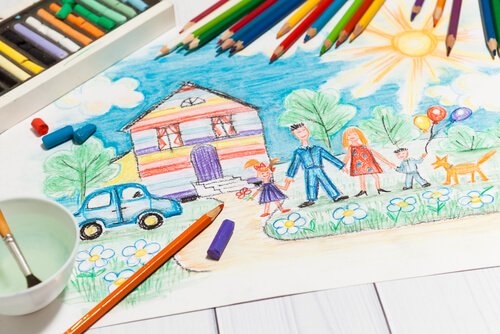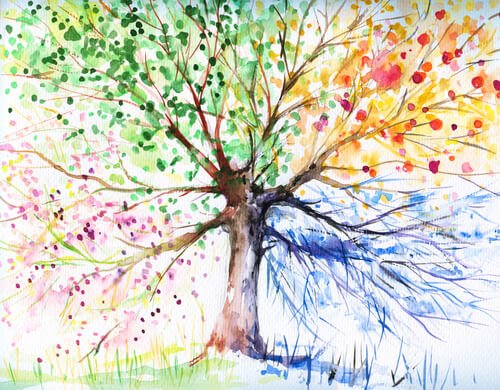Expressive Therapies: The Psychology of Drawing

Within the framework of expressive therapies, we can find the psychological interpretation of drawings. This can be an interesting resource in the evaluation of cases. Drawing tests can be a valuable source of information about the personal characteristics of the individual. For example, intelligence, motor coordination, learning abilities, and level of cognitive development.
Criticisms pertaining to these techniques have always been numerous and not unreasonable. Therefore, and despite being a useful tool, it’s important to keep in mind that they’re just another resource option along with other psychological assessment techniques.
Expressive therapies – its formal aspects
The analysis of expressive therapies should start from the moment the mental health professional administers them. There’s a lot of valuable information on how to start using them; the initial mood and degree of difficulty they pose to the patient.
Within the administration itself, it’s good to bear in mind the following aspects:
The size of the drawing
It represents the way you relate to the environment and everything that surrounds you. It tells about your self-esteem, your vital energy or the possible tendency to withdraw.
If your drawing takes up approximately 50% of the paper, it indicates a certain balance between extroversion and introversion.
On the other hand, if your drawing takes up the entire drawing surface, it speaks of an excess of self-esteem, and even certain aggressiveness. Now, if the drawing takes up less than 20% of the paper, it can be a sign of insecurity and impulse inhibition.
The projection and location of the drawing
If the drawing placed towards the left side, it’s a sign of introversion. However, if it’s placed towards the right side, it indicates extroversion.
Drawings located at the top of the paper indicate a tendency to follow a fantasy world, meaning it’s difficult for these people to adapt to reality. As children, we usually start to draw using this superior space and, as we grow, little by little we start to center it.
If it’s an adult who uses this part of the paper, we can suspect that they have a tendency to seek satisfactions far from reality.
The stroke
The stroke can be another important source of information.
- Strong strokes correspond to impulsive people, but also assertive.
- Meanwhile, a weak trace is a sign of shyness and low energy levels.
- Straight lines may indicate a lack of emotional control and curved lines speak of emotionality.
- Shadows and blots on the drawing may represent anxiety and an excess of uncertainty.
Asymmetry
Another interesting aspect is the asymmetry, which speaks of insecurity in relationships and emotional life in general.
The family drawing test
This is a very popular test, especially with children. It allows you to find out about the relationships that the individual has with the other members of their family. It considers:
- Who the person draws first.
- The size and proportions of the drawing.
- The person in the center of the drawing.
The distance between the figures is a scale that refers to the degree of emotional distance the individual has with the rest of the people represented in the drawing; the further away, the greater the emotional distance.
Similarly, figures at different heights could be an indication of communication problems.

The human figure drawing test
We can collect a lot of information by analyzing the representation of a human figure. Not only that, but extra aspects such as organs of the body and pieces of clothing exert great influence on it. Mental health professionals apply this test with children, adolescents, and adults. However, its effectiveness hasn’t been verified.
- Head: The bigger it is, the more intellectual frustrations it points out.
- Face: It has to do with social needs. When it’s omitted, it refers to evasive tendencies in the subject’s relationships. If they emphasize it too much to the point where it’s exaggerated, it means dominant and aggressive tendencies.
- Eyes: They represent social communication. If they’re very small, they can be an indicator of guilt. If they’re very big, they can hide dominant and aggressive tendencies. Now, closed eyes denote desires of isolation. Likewise, shallow eyes, (as in empty) denote egocentricity.
- Nose: If it appears shaded, omitted or abnormally big, it may symbolize some kind of sexual conflict.
- Hair: This aspect represents vital energy. It’s measured by the volume and strength of the strokes.
- Clothing: If the individual draws buttons, one could interpret that there’s a search for affection and protection. Large pockets are an index of internal conflicts. Finally, ties and hats are usually reinforcing the person’s sexual role. In adults, they’re seen as signs of overcompensation.
The tree test, one of the most popular expressive therapies
The tree test is a symbolic parallel with the individual that draws it. It’s one of the projective techniques that help to evaluate the development of the individual, as well as their cognitive disabilities, possible traumas, and their unconscious.
Spatial symbology:
- Roots: These represent instinct and unconscious content.
- Trunk: It represents the character (the ego).
- Cup: This is mental life in itself. We analyze its shape. If it’s large, it implies security and ambition. If it’s low, it’s an index of lack of will. Now, if it’s towards the left it represents introversion; on the right it represents self-confidence.
- Other elements: Every extra aspect is worth analyzing as well; the leaves, the fruits, the flowers, and the branches.

Drawing a house
When we draw a house, we’re shaping our family relationships in some way. Chimneys symbolize social contact: If smoke is coming out of it, we could say the individual’s quite effective. If there’s a path leading the entrance to the house, it symbolizes a need to approach others. If there’s a fence surrounding it, it talks about the individual’s concern about protecting their privacy.
From these basic drawings, you can find more tests within expressive therapies, but the elements would basically be analyzed in the same way as those explained here. It’s important to remember that while expressive techniques can be very creative and fun to use, they must always be combined with other instruments related to psychological evaluation.
Within the framework of expressive therapies, we can find the psychological interpretation of drawings. This can be an interesting resource in the evaluation of cases. Drawing tests can be a valuable source of information about the personal characteristics of the individual. For example, intelligence, motor coordination, learning abilities, and level of cognitive development.
Criticisms pertaining to these techniques have always been numerous and not unreasonable. Therefore, and despite being a useful tool, it’s important to keep in mind that they’re just another resource option along with other psychological assessment techniques.
Expressive therapies – its formal aspects
The analysis of expressive therapies should start from the moment the mental health professional administers them. There’s a lot of valuable information on how to start using them; the initial mood and degree of difficulty they pose to the patient.
Within the administration itself, it’s good to bear in mind the following aspects:
The size of the drawing
It represents the way you relate to the environment and everything that surrounds you. It tells about your self-esteem, your vital energy or the possible tendency to withdraw.
If your drawing takes up approximately 50% of the paper, it indicates a certain balance between extroversion and introversion.
On the other hand, if your drawing takes up the entire drawing surface, it speaks of an excess of self-esteem, and even certain aggressiveness. Now, if the drawing takes up less than 20% of the paper, it can be a sign of insecurity and impulse inhibition.
The projection and location of the drawing
If the drawing placed towards the left side, it’s a sign of introversion. However, if it’s placed towards the right side, it indicates extroversion.
Drawings located at the top of the paper indicate a tendency to follow a fantasy world, meaning it’s difficult for these people to adapt to reality. As children, we usually start to draw using this superior space and, as we grow, little by little we start to center it.
If it’s an adult who uses this part of the paper, we can suspect that they have a tendency to seek satisfactions far from reality.
The stroke
The stroke can be another important source of information.
- Strong strokes correspond to impulsive people, but also assertive.
- Meanwhile, a weak trace is a sign of shyness and low energy levels.
- Straight lines may indicate a lack of emotional control and curved lines speak of emotionality.
- Shadows and blots on the drawing may represent anxiety and an excess of uncertainty.
Asymmetry
Another interesting aspect is the asymmetry, which speaks of insecurity in relationships and emotional life in general.
The family drawing test
This is a very popular test, especially with children. It allows you to find out about the relationships that the individual has with the other members of their family. It considers:
- Who the person draws first.
- The size and proportions of the drawing.
- The person in the center of the drawing.
The distance between the figures is a scale that refers to the degree of emotional distance the individual has with the rest of the people represented in the drawing; the further away, the greater the emotional distance.
Similarly, figures at different heights could be an indication of communication problems.

The human figure drawing test
We can collect a lot of information by analyzing the representation of a human figure. Not only that, but extra aspects such as organs of the body and pieces of clothing exert great influence on it. Mental health professionals apply this test with children, adolescents, and adults. However, its effectiveness hasn’t been verified.
- Head: The bigger it is, the more intellectual frustrations it points out.
- Face: It has to do with social needs. When it’s omitted, it refers to evasive tendencies in the subject’s relationships. If they emphasize it too much to the point where it’s exaggerated, it means dominant and aggressive tendencies.
- Eyes: They represent social communication. If they’re very small, they can be an indicator of guilt. If they’re very big, they can hide dominant and aggressive tendencies. Now, closed eyes denote desires of isolation. Likewise, shallow eyes, (as in empty) denote egocentricity.
- Nose: If it appears shaded, omitted or abnormally big, it may symbolize some kind of sexual conflict.
- Hair: This aspect represents vital energy. It’s measured by the volume and strength of the strokes.
- Clothing: If the individual draws buttons, one could interpret that there’s a search for affection and protection. Large pockets are an index of internal conflicts. Finally, ties and hats are usually reinforcing the person’s sexual role. In adults, they’re seen as signs of overcompensation.
The tree test, one of the most popular expressive therapies
The tree test is a symbolic parallel with the individual that draws it. It’s one of the projective techniques that help to evaluate the development of the individual, as well as their cognitive disabilities, possible traumas, and their unconscious.
Spatial symbology:
- Roots: These represent instinct and unconscious content.
- Trunk: It represents the character (the ego).
- Cup: This is mental life in itself. We analyze its shape. If it’s large, it implies security and ambition. If it’s low, it’s an index of lack of will. Now, if it’s towards the left it represents introversion; on the right it represents self-confidence.
- Other elements: Every extra aspect is worth analyzing as well; the leaves, the fruits, the flowers, and the branches.

Drawing a house
When we draw a house, we’re shaping our family relationships in some way. Chimneys symbolize social contact: If smoke is coming out of it, we could say the individual’s quite effective. If there’s a path leading the entrance to the house, it symbolizes a need to approach others. If there’s a fence surrounding it, it talks about the individual’s concern about protecting their privacy.
From these basic drawings, you can find more tests within expressive therapies, but the elements would basically be analyzed in the same way as those explained here. It’s important to remember that while expressive techniques can be very creative and fun to use, they must always be combined with other instruments related to psychological evaluation.
This text is provided for informational purposes only and does not replace consultation with a professional. If in doubt, consult your specialist.







